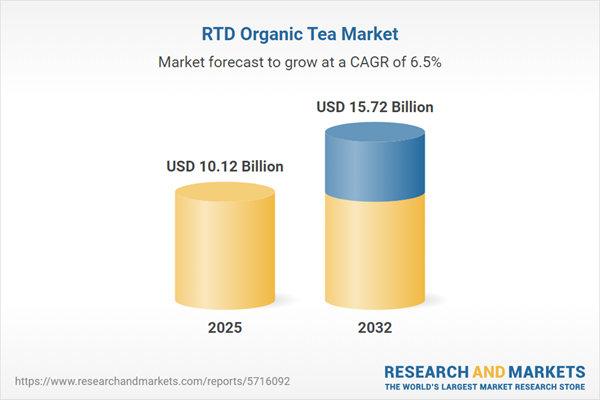Speak directly to the analyst to clarify any post sales queries you may have.
The global ready-to-drink organic tea market is experiencing notable transformation, with industry advancements and evolving consumer dynamics presenting a crucial opportunity for brands seeking resilience and growth in a rapidly changing beverage sector. Senior decision-makers will benefit from this concise synthesis of core market forces shaping the competitive landscape, regulatory scenarios, and innovation imperatives within this category.
Market Snapshot: Ready-to-Drink Organic Tea Market Overview
The ready-to-drink organic tea market grew from USD 9.52 billion in 2024 to USD 10.12 billion in 2025 and is projected to expand at a CAGR of 6.46%, reaching USD 15.72 billion by 2032.
Market expansion stems from increased demand for convenient, clean-label beverages as health-conscious consumers prioritize sustainable products. Strategic initiatives in processing, distribution, and consumer engagement are further driving momentum for established and emerging players globally.Scope & Segmentation of the Ready-to-Drink Organic Tea Market
- Product Types: Black Tea, Green Tea, Herbal Tea, Oolong Tea, White Tea
- Packaging Formats: Bottle, Can, Carton, Pouch
- Distribution Channels: Convenience Stores, Foodservice, Online Retail (Brand Websites and E-Commerce Platforms), Specialty Stores, Supermarkets/Hypermarkets
- Flavor Types: Floral, Fruit, Plain, Spiced
- Price Tiers: Mid-Range, Premium, Value
- Consumer Age Groups: Baby Boomers, Generation X, Generation Z, Millennials
- Regional Coverage: Americas (including North America and Latin America), Europe Middle East & Africa (Europe, Middle East, Africa), Asia-Pacific (covering major consumption and production hubs)
- Technology Integration: Adoption of aseptic packaging, blockchain traceability, cold-brew processes, and data-driven digital commerce initiatives
Key Takeaways for Senior Decision-Makers
- Clean-label and transparent ingredient sourcing continue to drive consumer loyalty, accelerating mainstream acceptance of ready-to-drink organic teas.
- Investments in processing technologies enable brands to improve shelf life while preserving nutritional value and authentic flavor profiles.
- Sustainability initiatives, such as ethical sourcing and eco-friendly packaging, have become essential to brand credibility and long-term market relevance.
- Segmentation by product type, flavor, and packaging allows for precision marketing and targeted innovation strategies across diverse consumer age groups.
- Digitally enabled commerce models—such as direct-to-consumer and subscription services—strengthen customer engagement and provide actionable insights into evolving preferences.
- Regional dynamics require tailored product portfolios and distribution methods, reflecting local culture, regulatory frameworks, and consumption habits.
Tariff Impact: Navigating Cost and Supply Chain Adjustments
New tariffs in the United States have notably increased costs associated with agricultural inputs and packaging for the ready-to-drink organic tea segment. As a result, manufacturers are refining sourcing tactics and negotiating with a broader group of suppliers, balancing procurement across traditional and emerging regions. Some brands absorb incremental costs to maintain pricing, while others adapt tiered pricing strategies reflecting variations in sourcing and production.
Methodology & Data Sources
This market intelligence is based on secondary research drawn from industry publications, regulatory filings, and financial disclosures, alongside primary data via interviews with executives, supply chain specialists, and growers. Consumer surveys and expert advisory panels further validate segmentation and strategic recommendations, ensuring robust data triangulation and analytical rigor.
Why This Report Matters
- Provides actionable insights for protecting margins and leveraging sustainable growth avenues within the ready-to-drink organic tea ecosystem.
- Equips leadership with comprehensive segmentation and technology adoption benchmarks for robust, future-oriented business planning.
Conclusion
The ready-to-drink organic tea market is advancing through innovation, sustainability, and regionally adapted strategies. Informed supplier relationships, technological adoption, and segmentation-centric focus will remain critical for ongoing competitive advantage and value creation.
Additional Product Information:
- Purchase of this report includes 1 year online access with quarterly updates.
- This report can be updated on request. Please contact our Customer Experience team using the Ask a Question widget on our website.
Table of Contents
3. Executive Summary
4. Market Overview
7. Cumulative Impact of Artificial Intelligence 2025
Companies Mentioned
The companies profiled in this RTD Organic Tea market report include:- The Coca-Cola Company
- PepsiCo, Inc.
- Ito En, Ltd.
- Keurig Dr Pepper Inc.
- The Hain Celestial Group, Inc.
- Unilever PLC
- Nestlé S.A.
- Kirin Holdings Company, Limited
- Suntory Holdings Limited
- Danone S.A.
Table Information
| Report Attribute | Details |
|---|---|
| No. of Pages | 195 |
| Published | October 2025 |
| Forecast Period | 2025 - 2032 |
| Estimated Market Value ( USD | $ 10.12 Billion |
| Forecasted Market Value ( USD | $ 15.72 Billion |
| Compound Annual Growth Rate | 6.4% |
| Regions Covered | Global |
| No. of Companies Mentioned | 11 |









